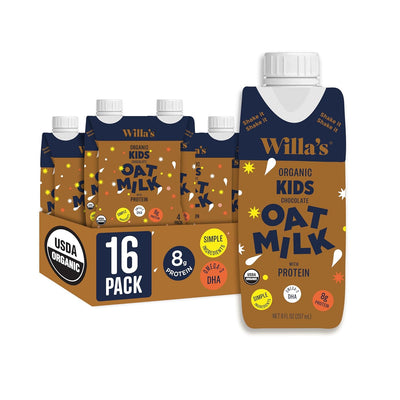Is Oat Milk Gluten Free?

There has been a lot of discussion over gluten over the past few decades. Gluten sensitivity, as well as Celiac Disease, are on the rise. One of the reasons many medical professionals believe Celiac Disease is on the rise is due to the use of glyphosate (Round-Up) on conventional wheat just before harvest.
We often get asked the question, do oats have gluten?
What does it mean to be gluten-free?
Eating gluten-free means avoiding all foods containing gluten. Gluten is a naturally occurring protein found in wheat, barley, and rye. With that, any foods that contain wheat, barley, and rye also contain gluten.
Those who are extremely sensitive to gluten, especially those with Celiac Disease, also avoid non-gluten ingredients that come into contact with gluten.
Here is what Beyond Celiac has to say about cross-contact and gluten-free certifications:
“Cross-contact is when a gluten-free food or food product is exposed to a gluten-containing ingredient or food – making it unsafe for people with celiac disease to eat.”
“It is important to know how your food is made, from farm to table, in order to avoid possible gluten exposure. To voluntarily label a product gluten-free in the U.S., it must contain less than 20 ppm gluten, as mandated by the FDA. However, if a product is NOT labeled gluten-free, but you do not see any gluten-containing ingredients listed, this does not mean that it is under the same 20 ppm threshold. This is because manufacturers are not required to call out “gluten” in food products; the FDA gluten-free labeling rule is voluntary for food manufacturers. To determine whether there was a risk of cross-contact during the growing and/or manufacturing processes, it is best to call the manufacturer and inquire whether they batch test their product for gluten, if they know how their raw materials were sourced and produced, and what procedures they go through to prevent cross-contact in the factory.”
Why are there so many more gluten-free products today?
You may have noticed that in recent years, so many more products on the market are gluten-free or have gluten-free alternatives. A 2020 report estimated that roughly 20 to 30 percent of Americans either currently follow or once followed a gluten-free diet without medically confirmed gluten intolerances. Beyond that, approximately 2 million Americans are diagnosed with celiac disease, an autoimmune response to gluten.
With increased information available and more education around the health impacts of gluten, many more Americans are understandably seeking gluten-free food options. As a result, the market is listening and more and more brands are jumping on the opportunity to provide delicious gluten-free foods, especially because eating gluten-free is medically necessary for so many.
Why do people avoid gluten?
As mentioned above, millions of Americans have medical gluten intolerances, but different people react to gluten in various ways and hold different levels of gluten sensitivity. Some symptoms of gluten sensitivity include inflammatory responses like bloating, fatigue, abdominal pain, diarrhea, and more. To avoid these discomforts, gluten-sensitive people will decrease quantities, stick to sourdough bread which is naturally lower in gluten, or completely cut out gluten from their diets.
For those with Celiac Disease, avoidance of any gluten cross contact is crucial. If you’re wondering if you have Celiac Disease, Celiac Disease Foundation recommends speaking with your doctor about getting tested.
Is there gluten in oats?
In their pure form, oats do not contain gluten. The only grains that naturally contain the protein gluten are wheat, barley, rye, and triticale. From the Gluten Intolerance Group, “Oats are not considered a top allergen, and in their pure form, oats are safe for the majority of people with celiac disease. Unlike wheat, barley, and rye, oats are not considered a source of gluten in many countries,” including the United States where the FDA considers oats a gluten-free grain. However, there is a risk in all gluten-free foods, including oats, of cross-contact with gluten. Cross-contact occurs when " foods or ingredients come into contact with gluten, generally through... shared cooking/storage environment[s]. In order for food to be safe for someone with celiac disease, it must not come into contact with food containing gluten."
Why aren’t all oat products gluten-free?
Although oats do not naturally contain gluten, the journey from field to production to plate is long with many factors that risk contacting the oats with gluten. Because many grains - including wheat, rye, and barley - are grown and processed near other grains, there is a possibility for agricultural commingling.
Is Willa’s Oat Milk gluten free?
There are no gluten ingredients in our oat milk. As explained above, with any oat product, there is always a chance that the transport or storage of the oat crops had wheat, barley, or rye in it before and there could be trace amounts of gluten left in the batch of oats.
Regarding gluten testing, Willa’s organic oats may range from 50 to 300 parts per million. Here's what the Celiac Disease Foundation has to say on oats and the potential for contamination.
If you have any further questions, please don’t hesitate to reach out to willasteam@willaskitchen.com.
Have more questions about Willa’s? Check out our FAQ page!
Learn more about Willa’s unique whole oat approach here.
Wondering how our whole oat approach relates to food waste and sustainability? Check this out.
Read about the advantages of organic oat milk here.
Find more information about oats, oat milk, and more on our blog page.
For delicious oat milk recipe inspiration, browse our recipe page.
Shop Willa’s Oat Milk here!







